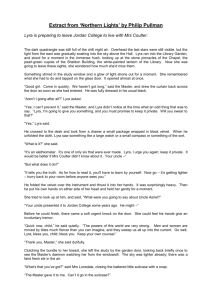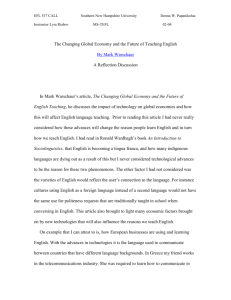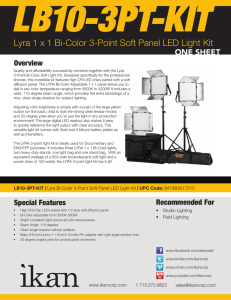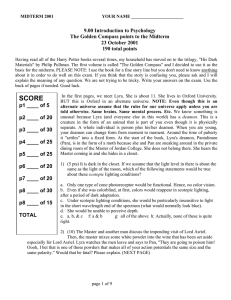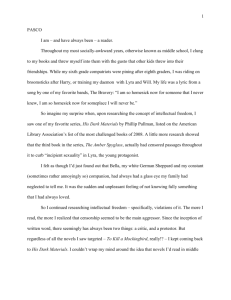Status and Last Results L Y R
advertisement
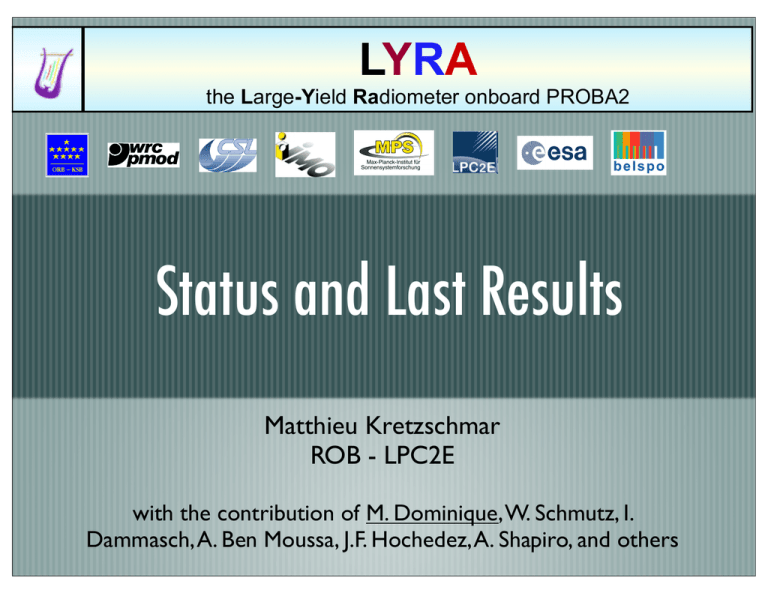
LYRA the Large-Yield Radiometer onboard PROBA2 Status and Last Results Matthieu Kretzschmar ROB - LPC2E with the contribution of M. Dominique, W. Schmutz, I. Dammasch, A. Ben Moussa, J.F. Hochedez, A. Shapiro, and others The LYRA radiometer ➡ 3 instrument units (redundancy) ➡ 4 spectral channels per head (Ly 121.6nm, Hz 200-220nm, Al 17-80nm, Zr 6-20nm) ➡ 3 types of detectors, Silicon + 2 types of diamond detectors (MSM, PIN): - radiation resistant - insensitive to visible light compared to Si detectors ➡ High cadence up to 100 Hz The LYRA radiometer ➡ 3 instrument units (redundancy) r i f 9, ➡ 4 spectral channels per head 0 0 2 Al 2 (Ly 121.6nm, Hz 200-220nm, v o 17-80nm, Zr 6-20nm) N n 10 o 0 h 2 c n 6 ➡ 3 types of detectors, Silicon + 2 u y a r l a ➡ ofndiamond u types detectors (MSM, a PIN):J - radiation resistant - insensitive to visible light compared to Si detectors ➡ High cadence up to 100 Hz n o t h g i l st LYRA Channels and Units Channel1 Channel2 Channel3 Channel4 Long term calibration Nominal Special Campaign pre-flight spectral responsivity Channel 1: H I 121.6 nm (+ red wing) Channel 2: 200-220 nm Herzberg continuum (190-222 nm) Channel 3: Alu filter: 17-80 nm (+ <5nm Xray) Channel 4: Zr: 6-20 nm (+ <2nm X-ray) pre-flight spectral responsivity Channel 1: H I 121.6 nm (+ red wing) Channel 2: 200-220 nm Herzberg continuum (190-222 nm) Channel 3: Alu filter: 17-80 nm (+ <5nm Xray) Channel 4: Zr: 6-20 nm (+ <2nm X-ray) Red wing of Ly SXR contribution Calibration: current status Level1, «Engineering»: Counts / integration time : Frequency Level2, Calibrated: dark current, degradation, conversion in physical units Degradation Ly a } - 99% ! Hz 17-80 nm 6-20 nm - 90% ! - 20% ! Degradation Channel 2-1 and 2-2 are probably currently dominated by the noise. Degradation attributed to filters (signal from diode @235nm and 375nm nearly constant) Degradation correction will be improved in the future. Conversion into physical units Use TIMED and SORCE observed spectrum shape at first light, (January 6 2010) and compare values : Mean (over unit) Lyra first light flux vs TIMED/SORCE ➡Scale Lyra Value to TIMED/SORCE ones. Different value for Lyman alpha: unit1 : +81.3 %, unit2 : +91.2%, unit3 : +3.3%. Probable error in unit 1 and 2 from between 240 and 300nm. Special (still uncorrected) features in LYRA data Flat-field: Proba2 pointing is stable up to 5arcsec /min (from SWAP). Jitter introduces fluctuations in the Lyra signal of less than 2%. Special (still uncorrected) features in LYRA data Large Angle Manoeuver (or rotation): Four times an orbit, the spacecraft rotates of 90 around the axis pointing toward the Sun, to avoid Earth shadowing its star trackers. From October to February, occultation by the Earth («eclipse» denomination is kept for the moon) Slow MSM stabilization Electronic induced perturbations linked to change of operational mode. Special (still uncorrected) features in LYRA data (continued) SAA perturbations: secondary electrons generated by high energetic protons hit the detectors. Mostly in Si detectors only ! Auroral zone when Kp > 4: all detectors, mainly Al and Zr (airglow ? SWAP -17.4nm- does not see them) Data distribution Data are available within 4 hours of their acquisition and are distributed through the Proba2 website (proba2.sidc.be): uncalibrated, calibrated data, quicklooks PROBA2 specific features appears in all these LYRA data product. A quicklook ? Go here: http://proba2.sidc.be/lyra/LY-QLV/ Some Results Irradiance Oscillations X2.2 flare on February 15th 2011. Oscillations or quasi periodic pulsation (QPP) in all coronal channels. Rising phase of the flare. Plasma (or MHD) waves of unclear origin. Can lead to plasma parameter. L. Dolla, C. Marqué, ... (ROB) L. Dolla, C. Marqué, in prepatation. Irradiance oscillations (2) signal-smooth(signal) Filtered signal M2 flare on February 8 2010 Oscillations observed in LYRA Channel 3 and 4. Also in Ly-a ! Deduce a plasma- of 0.4 Van Doorsselaere et al., ApJ, 2011 Flare in Lyman LYRA Observations on February 8, 2010. H- (Kanzelohe Obs) M2 flare. 0.2% LYRA: Ly Ly H Rhessi 3-25kev SEM 30.4nm H (zoomed) WL difference GOES 0.1-0.8nm Kretzschmar et al., in preparation Flare in Lyman Flare energy budget: chromospheric (low contrast, big energy) vs coronal radiation (opposite). Which energy at which wavelength is received by the Earth ? Is the flare rate modulated on long term (solar cyle and more) and what would be its contribution to the SSI variability ? Using LYRA for testing SSI model Irradiance empirical models relies on 1) thermal and density structure of the solar atmosphere (here FAL) and 2) radiative transfer code (here COSI). Lack of knowledge of atomic data leads to the need of additional (empirical) opacities in the 160-320nm range. Matching the irradiance level can thus be done by «playing» with both atmospheric model and these empirical additional opacities. However, for the same irradiance level, two sets of (atmospheric model & additional opacities) lead to different center to limb variation. Shapiro et al. (2011) use LYRA eclipse observation to constrain their mode COSI. CLV curves brings new constraint on missing opacities in the UV region. The Future New corrections to be included. Cross-calibration EUV workshop in Boulder (Oct 2011) For now, results mainly concentrate on short time scale & Flare (2 short ’s channels can be considered as GOES SXR alternative/ complement) Studies on mid-term variability (several rotations) to come. The Future Topical issue on PROBA2 (LYRA & SWAP) to come soon in Solar Physics. First Light paper will be there. Mission founded till end 2012, we are looking after a second extension till 2014 by ESA Science Programme Committee (SPC). thank you Diamond Detector: Quick Facts MSM PIN Blind to radiation > 300 Radiation hard Calibration: current status Onboard: photocurrent -> Voltage -> Frequency -> Counts Ground: Level1, «Engineering»: Counts / integration time : Frequency Level2, Calibrated: dark current, degradation, conversion in physical units
